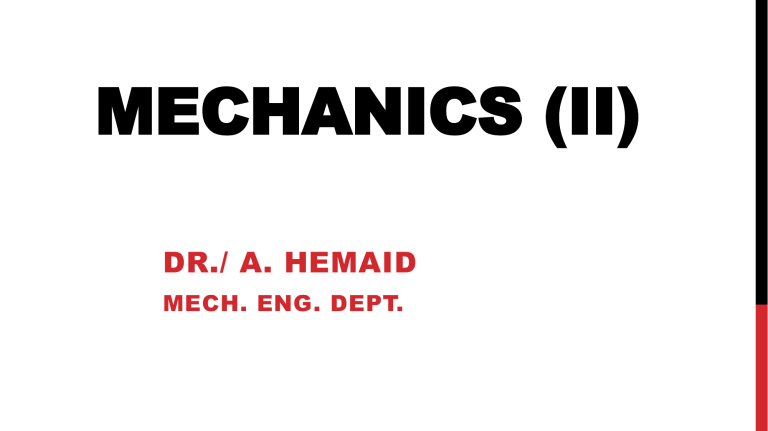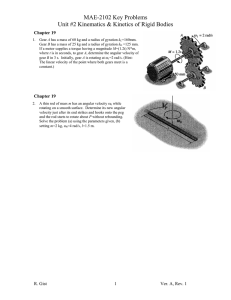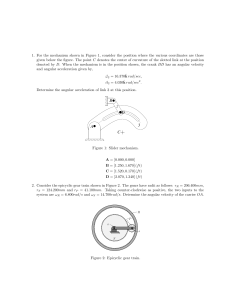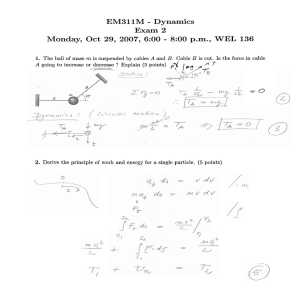
MECHANICS (II) DR./ A. HEMAID MECH. ENG. DEPT. Sample Problem (1) The double gear shown rolls on the stationary lower rack; the velocity of its center A is 1.2 m/s directed to the right. Determine (a) the angular velocity of the gear, (b) the velocities of the upper rack R and of point D of the gear A) ANGULAR VELOCITY OF THE GEAR. vA = vc + vA/c vA/C = r1ω vA = 1.2 m/s and r1 = 150 mm = 0.150 m 1.2 m/s = (0.150 m)ω ω = 8 rad/sec. A VA = 1.2 m/s A VC = 0 VA/C = r1 ꞷ ꞷ C C B) VELOCITIES. vR = vB = vA + vB/A = vA + ωk x rB/A = (1.2 m/s)i + (8 rad/s)k x (0.100 m)j = (1.2 m/s)i + (0.8 m/s)i = (2 m/s)i vR = 2 m/s . Velocity of Point D vD = vA + vD/A = vA + ωk x rD/A = (1.2 m/s)i + (8 rad/s)k x (-0.150 m)i = (1.2 m/s)i + (1.2 m/s)j vD = 1.697 m/s at 45• . Sample Problem (2) In the engine system shown, the crank AB has a constant clockwise angular velocity of 2000 rpm. For the crank position indicated, determine (a) the angular velocity of the connecting rod BD, (b) the velocity of the piston P. SOLUTION Motion of Crank AB. The crank AB rotates about point A. Expressing vAB in rad/s and writing vB = rωAB, we obtain vB = (AB)vAB = (3 in.)(209.4 rad/s) = 628.3 in./s vB = 628.3 in./s at 50° Motion of Connecting Rod BD. We consider this motion as a general plane motion. Using the law of sines, we compute the angle b between the connecting rod and the horizontal: vD = vB + vD/B vD/B = 495.9 in./s vD/B = 495.9 in./s at 76.05° vD = 523.4 in./s = 43.6 ft/s vD = 43.6 ft/s vP = vD = 43.6 ft/s ◀ Since vD/B = lωBD, we have 495.9 in./s = (8 in.) ωBD ωBD = 62.0 rad/s PROBLEM 2 SHEET 3-02 Small wheels have been attached to the ends of rod AB and roll freely along the surfaces shown. Knowing that wheel A moves to the right with a constant velocity of 1.5 m/s, determine (a) the angular velocity of the rod, (b) the velocity of end B of the rod Given: vA = 1.5 m/s, Required (a) the angular velocity of the rod, (b) the velocity of end B of the rod A vA = 1.5 m/sec 60o 20o B Taking A as a base point vB = vA + vB/A vB vB/A 20o 60o 70o 60o vA 20o vB/A vA vB Taking A as a base point vB = vA + vB/A y vA 20o 60o vB/A 20o vB x ∑y component = 0 vA sin 60 = vB/A sin 50 vB/A = vA sin 60/ sin 50 = 1.5 * 0.5 / 0.766 = 1.696 m/sec But vB/A = ω * 0.720 ω = 1.696 / 0.750 = 2.26 rad /sec ∑x component = vB vB = vB/A cos 50 + vA cos 60 = 1.09 + 0.75 = 1.84 m/sec INSTANTANEOUS CENTER OF ROTATION IN PLANE MOTION It is the point which all the points of the body in general plane motion rotate around it instantaneously To determine the I.C. , the direction of the velocities of two different should be known. Draw perpendicular to each velocity to meet at I. C. C will be at ∞ vB always directed vertically downward. vA always directed horizontally to the right Draw two perpendicular to the direction of the given velocities to meet at C Given vA you can get ω vA vA AC l cos And vB SAMPLE PROBLEM (4) The double gear shown rolls on the stationary lower rack; the velocity of its center A is 1.2 m/s directed to the right. Determine (a) the angular velocity of the gear, (b) the velocities of the upper rack R and of point D of the gear vA = rAω 1.2 m/s = (0.150 m)ω ω = 8 rad/s i . Velocity of Upper Rack. Recalling that vR = vB, vR = vB = rBω vR = (0.250 m)(8 rad/s) = 2 m/s vR = 2 m/s . Velocity of Point D. Since rD = (0.150 m)√2 = 0.2121 m, v D = rDω vD = (0.2121 m)(8 rad/s) = 1.697 m/s vD = 1.697 m/s at 45 PROBLEM 2 SHEET 3-02 Small wheels have been attached to the ends of rod AB and roll freely along the surfaces shown. Knowing that wheel A moves to the right with a constant velocity of 1.5 m/s, determine (a) the angular velocity of the rod, (b) the velocity of end B of the rod vA = 1.5 m/sec A 70o 60o 20o B 30o 60o I AB IA IB Sin60 Sin50 Sin70 AB Sin50 0.75(0.766) IA 0.663m Sin60 0.866 AB Sin70 0.75(0.94) IA 0.814m Sin60 0.866 VA IA 1.5 0.663 1 .5 2.26rad / s 0.663 VB IB 2.26(0.814) 1.84m / s EXAMPLES Determine the moment of inertia and the radius of gyration of the shaded area with respect to the x axis and y-axis. The beam AB supports two concentrated loads and rests on soil that exerts a linearly distributed upward load as shown. Determine the values of wA and wB corresponding to equilibrium. •The composite body shown is formed by removing a semiellipsoid of revolution of semimajor axis h and semi-minor axi a/2 from a hemisphere of radius a. Determine The y coordinate of the centroid when h = a/2, The ratio (h/a) for which Ῡ = 0.4a EXAMPLE No. (6) SHEET (3) A thin semicircular plate has a radius a and a mass m. Determine the mass moment of inertia of the plate with respect to (a) the centroidal axis BB′, (b) the centroidal axis CC′ perpendicular to the plate. that is Mass (m) = ρtA Imass = ρtIarea = (m/A) Iarea I AA' area I DD 'area I dia A=(1/2) πa2 1 4 1 4 a a 2 4 8 m m 1 4 1 2 I AA' mass I DD 'mass I AA'area a ma 1 2 8 4 A a 2 2 1 2 4a 2 I BB ' I DD ' m( AC ) ma m 4 3 I BB ' (0.25 0.1801)ma 2 I CC ' 1 2 I AA' I BB ' ma 0.0699ma 2 4 I BB ' 0.0699ma 2 I CC ' 0.320ma 2 EXAMPLE NO. (8) SHEET (3) The area shown is revolved about the x axis to form a homogeneous solid of revolution of mass m using direct integration, express the mass moment of inertia of the solid with respect to the x axis in terms of m and h. x rh a 2h h xh =a(r-h) xh + ah =ar h x a r r-h 2h-h 2h EXAMPLE NO. (10) SHEET (3) Determine the mass moment of inertia of the 0.9-lb machine component shown with respect to the axis AA′. h 0 .2 1 h 2 .4 0 .6 3 3h = h + 2.4 h = 1.2 in h 0.2 2.4 0.6 EXAMPLE N0. 2 SHEET (4) Rod AB moves over a small wheel at C while end A moves to the right with a constant velocity of 25 in./s. At the instant shown, determine (a) the angular velocity of the rod, (b) the velocity of end B of the rod. AC (10) (7) 12.2in 2 2 I.C. 10 tan 55o 7 AC cos IA 1 ω AC 12.2 IA 21.3in cos cos 55 IC AC tan 55o 12.2 tan 55 17.4in VA IA VA 25 1.175rad / s IA 21.3 BC AB AC 20 12.2 7.8in IB ( IC ) 2 ( IB) 2 (17.4) 2 (7.8) 2 19.07in VB IB 1.175 19.07 22.4in / s θ θ VA = 25 in/s 7 tan 35o 10 1 β VA VC / A AC VA cos(90 ) 12.2066 25 cos(55) 1.175rad / s VC VA cos 25 cos 35 20.479in / s β 90-β VA VB/A tan 1 VB / C BC 1.175 7.7934 24.09 o VC VC 20.479 VB / C BC 1.175 7.7934 9.157in / s VB / C 9.157 VB 22.43in / s sin sin 24.09 Inclination of VB equals β + Φ = 35 + 24.09 = 59.09o β VA VB/C VB VB/A Φ VC 90-β β VA EXAMPLE N0. 4 SHEET (4) Knowing that at the instant shown the angular velocity of rod BE is 4 rad/s counterclockwise, determine (a) the angular velocity of rod AD, (b) the velocity of collar D, (c) the velocity of point A. ω1 = 4 rad/s VB = ω1 x BE = 4 x 0.192 = 0.768m/s IB = 360 sin 30o = 180mm = 0.18m ID = 360 cos 30o = 311.77mm = 0.31177m VB = ω2 x IB ω2 = 4.27 rad/s VB 0.768 2 4.27 rad / s IB VA ω1 0.18 VD = ω2 x ID = 4.27 x 0.31177 = 1.33m/s IA ( AD ) 2 ( ID) 2 2( AD )( ID) cos 30 VB 30 ω2 VD = 1.33 m/s IA (0.6) 2 (0.31177) 2 2(0.6)(0.31177) cos 30 0.365 I.C. A VD VA = ω2 x IA = 4.27 x 0.365 = 1.48m/s VA = 1.559 m/s I 30 0.31177 D ω1 = 4 rad/s VB = ω1 x BE = 4 x 0.192 = 0.768m/s VB VD = VB + VD/B VD/B = ω2 x BD = 0.36 ω2 60 VD VA 30 VD / B VB 0.768 1.536m / s sin 30 0 .5 ω1 VD/B 30 VB ω2 VD/B = 0.36 ω2 = 1.536 ω2 = 4.267 rad/s VD = VD/B cos 30 = 1.536 cos30 = 1.33 m/s VD = 1.33 m/s I.C. VD VD/B VA = VB + VA/B V(A)X = VB + VA/B cos 60 VA V(A)X = 0.768 + ω2 (0.24) cos 60 V(A)X = 0.768 + 4.267(0.24) cos 60 = 1.28 m/s ω1 30 V(A)Y = VA/B sin 60 = 4.267(0.24) sin60= 0.8869 m/s 2 2 V A V AX V AY (1.28) 2 (0.8869) 2 1.557 m / s 1 0.8869 tan 34.7 o 1.28 VA/B VB ω2 I.C. VD VA/B sin60 VD/B 60 VB VA/B cos60 Absolute and relative acceleration in plane motion aB = aA + aB/A (aB/A)t = α x rB/A (aB/A)t = rα (aB/A)n = -ω2rB/A (aB/A)n = rω2 aB = aA + αxrB/A - ω2 rB/A A A A aA B aB aA = B + aA aB aA aB/A (aB/A)n (aB/A)t (aB/A)n B (aB/A)t Sample Problem (3-6) The center of the double gear has a velocity of 1.2 m/s to the right and an acceleration of 3 m/s2 to the right. Recalling that the lower rack is stationary, determine (a) the angular acceleration of the gear, (b) the acceleration of points B, C, and D of the gear SOLUTION a. Angular Acceleration of the Gear. vA = -r1ω 1.2 m/s = -(0.150 m)ω ω = -8 rad/s aA = -r1α 3 m/s2 = -(0.150 m)α α = -20 rad/s2 α = αk = -(20 rad/s2)k ◀ b. Accelerations. The rolling motion of the gear is resolved into a translation with A and a rotation about A. Acceleration of Point B. aB = aA + aB/A = aA + (aB/A)t + (aB/A)n = aA + α x rB/A - ω2rB/A = (3 m/s2)i - (20 rad/s2)k x (0.100 m)j - (8rad/s)2(0.100 m)j = (3 m/s2)i + (2 m/s2)i - (6.40 m/s2)j aB = (5m/s2)i – (6.40m/s2)j a B (5) (6.4) 8.12m / s 6 .4 tan 1.28 5 o 52 2 2 2 Acceleration of Point C aC = aA + aC/A = aA + αk x rC/A - ω2rC/A = (3 m/s2)i - (20 rad/s2)k x (20.150 m)j - (8 rad/s)2(20.150 m)j = (3 m/s2)i - (3 m/s2)i + (9.60 m/s2)j ac = 9.6 m/s2 ↑ Acceleration of Point D aD = aA + aD/A = aA + αk x rD/A - ω2rD/A = (3 m/s2)i - (20 rad/s2)k x (20.150 m)i - (8 rad/s)2(20.150 m)i = (3 m/s2)i + (3 m/s2)j + (9.60 m/s2)i = 12.6m/s2 i + 3m/s2 j a B (12.6) 2 (3) 2 12.95m / s 2 12.6 tan 4 .2 3 76.6 o SAMPLE PROBLEM (7) Crank AB of the engine system has a constant clockwise angular velocity of 2000 rpm. For the crank position shown, determine the angular acceleration of the connecting rod BD and the acceleration of point D. SOLUTION Motion of Crank AB. ωAB = 2000 rpm = 209.4 rad/s, (constant) αAB = 0 aB = rω2AB = (5/12ft) (209.4 rad/s)2 = 10,962 ft/s2 aB = 10,962 ft/s2 at 40° MOTION OF THE CONNECTING ROD BD. VBD = 62.0 rad/s β = 13.95° (aD/B)n = (BD)ω2BD = ( 8/12 ft) (62.0 rad/s)2 = 2563 ft/s2 (aD/B)n = 2563 ft/s2 at13.95° (aD/B)t = (BD)αBD = ( 8/12 )aBD = 0.6667αBD (aD/B)t = 0.6667αBD at 76.05° aD = aB + aD/B = aB + (aD/B)n + (aD/B)t [aDG] = [10,962 at 40°] + [2563 at 13.95°] + [0.6667aBD at 76.05°] Equating x and y components, we obtain the following scalar equations: x components: -aD = 210,962 cos 40° - 2563 cos 13.95° + 0.6667aBD sin 13.95° y components: 0 = 210,962 sin 40° + 2563 sin 13.95° + 0.6667aBD cos 13.95° Solving the equations simultaneously, we obtain aBD = 19940 rad/s2 and aD = 19290 ft/s2. aBD = 9940 rad/s2 ◀ aD = 9290 ft/s2 ◀ SAMPLE PROBLEM (3-8) The linkage ABDE moves in the vertical plane. Knowing that in the position shown crank AB has a constant angular velocity ω1 of 20 rad/s counterclockwise, determine the angular velocities and angular accelerations of the connecting rod BD and of the crank DE





